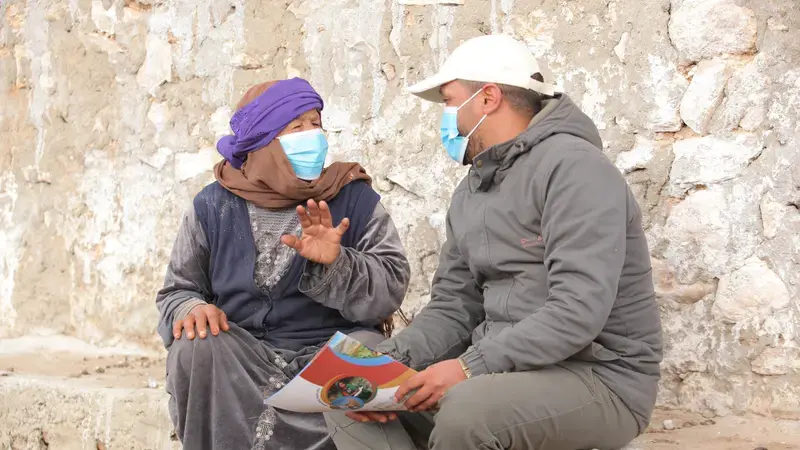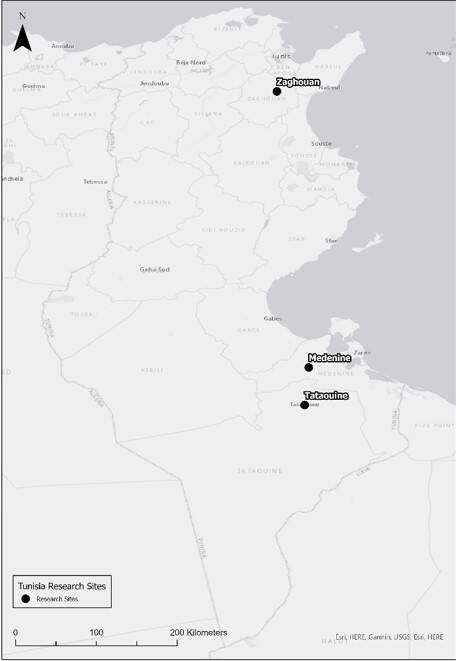Rangeland Women: Why Supporting Them Could Save Tunisia’s Degraded Ecosystems

Funding from CRP Livestock - Environment Flagship and the CGIAR Gender Platform have made this study possible. The authors are grateful for the participants' generosity and time.
----------------
Across the drylands, there is a widespread misconception surrounding rural women's involvement in rangelands.
Women's roles in livestock rearing, crop cultivation, and climate change adaptation, are either diminished or altogether invisible, perpetuating a loop of missed opportunities and a lack of institutional support. Tunisia is no exception.
ICARDA Gender Scientist Dina Najjar and Bipasha Baruah -who holds the Canada Research Chair in Global Women's Issues at the University of Western Ontario - debunk the myth that rangeland activities are primarily male-oriented and male performed in an upcoming paper.
Their study calls for emerging policies to reflect and integrate rangeland women's priorities and skills and facilitate their access to training and resources.
"Women's contribution to rangeland cultivation and management in Tunisia is a major policy blind spot. Their specific vulnerability to climate change is also largely overlooked," says Dina Najjar.
Rangelands are critical yet fragile ecosystems in Tunisia. They sustain pastoral systems and local economies and act as a buffer against the spread of desertification.
Estimates suggest that rangelands, which cover 5.5 million hectares of land in Tunisia, generate 1,062 million Tunisian Dinars in goods and services each year (equivalent to 1.5% of GDP and three times the value produced by forests).
But this ecosystem is threatened by rampant desertification. Between 2005 and 2012, a whopping 600,000 hectares of previously productive rangeland disappeared.
Prompted by overgrazing, crop encroachment, complex land tenure systems, limited human capacity, little data availability, and climate change, desertification continues to wreak havoc on ever-larger swaths of rangelands, affecting communities' livelihoods.
To determine whether rangeland ecosystems are as reliant on female labor as they are on men's to function, Drs. Najjar and Baruah spoke to 289 individuals during interviews and focus groups across three northern and southern Tunisian governorates.

While doing the research, the two scientists felt gripped by a growing sense of momentum - urgency even. "The Tunisian pastoral code is under reformulation at the moment, and we simply could not miss the opportunity to make women's contribution visible and provide key policy inputs," says Najjar.
To understand the nature of the work performed by Tunisian women in rangeland management and the extent of their contribution, Dina Najjar and Bipasha Baruah spoke to men and women in the northern governorate of Zaghouan and in the two southern provinces of Medenine and Tataouine. (see map)
Compared to Medenine and Tataouine, which are very drought-prone and heavily dependent on rangelands for livestock feed, Zaghouan's milder weather means that crops such as feed and forage, wheat, and olives can grow.
Therefore, while livestock rearing is the most advantageous economic activity in the south (especially in Tataouine, where families own 80 camel heads on average) people in Zaghouan can rely on multiple income sources. Livestock remains essential, but other lifelines exist in parallel.
In dry, marginal areas, where crop cultivation is unreliable, livestock rearing is a crucial component of community resilience and livelihoods. In addition to providing meat and milk, livestock can be used for agricultural work support and act as financial safety nets.
"We went to these communities to get information on herd sizes, women's and men's roles in agriculture and livestock rearing, patterns of land access and ownership by gender, as well women and men's perceptions of climate change and coping strategies," explains Dina Najjar.

Picture by Zied Idoudi
One of the major takeaways from the study is that women's involvement in livestock grazing and rearing activities is way more significant than is generally assumed. Still, women are involved in different aspects of the work than men.
The study also highlighted that while men and women were negatively affected by rangeland degradation, worsening water scarcity conditions, and inadequate access to agricultural extension services, gender norms and cultural practices put women at a starker disadvantage.
Since women rarely own land and cannot offer land titles as collateral, they struggle to access loans and credits. Training available to men in rangeland rehabilitation, irrigation, drought mitigation and climate change adaptation is yet to include women, widening men and women's skills gap.
"Our research shows that men bear more of the financial stress arising from climate change. For women, climate change appears to be associated with them taking up more manual labor, and its associated drudgery," Bipasha Baruah points out. In realistic terms, women must walk longer distances to collect forage and spend more time bathing and cleaning up after the animals.
The study reveals that rural women in Tunisia are more actively involved in grazing livestock, livestock rearing, and crop production than was broadly assumed in practitioner and policy circles.
"Women dedicate a lot of time to raising livestock, and also participate, albeit to a lesser extent than men, in decision-making on livestock and rangeland management, through cooperatives," says Dina Najjar.
In a context of accelerating climate change, men and women who inhabit rangelands need access to adequate support to optimize cultivation and productivity.
This study advocates for social and economic policy interventions capable of responding to those urgent needs, just as work on reformulating Tunisia's pastoral code is underway.
--------------------
Funding from CRP Livestock - Environment Flagship and the CGIAR Gender Platform have made this study possible.

References:
-Ayantunde, A., Yameogo, V., Traore, R., Kansaye, O., Kpoda, C., Saley, M., Descheemaeker, L., Barron, J. (2017). Improving livestock fodder production through greater inclusion of women and youth: results from "realizing the full biomass potential of mixed crop-livestock systems in rapidly changing Sahelian agro-ecological landscapes" project. Water, Land and Ecosystems Briefing Series, 10, n.p.
-Bageant, E.R., Barrett, C.B. (2017). Are there gender differences in demand for index-based livestock insurance? The Journal of Development Studies, 53(6), 932–952.
-Chanamuto, N.J.C., Hall, J.G. (2015). Gender equality, resilience to climate change, and the design of livestock projects for rural livelihoods. Gender and Development, 23(3), 515–530.
-Werner, J. et al. 2018. A new pastoral code for Tunisia: Reversing degradation across the country’s critical rangelands. Tunis: ICARDA/ Direction Générale des Forêts (DGF), Ministère de l’Agriculture et des Ressources Hydrauliques et de la Pêche.
